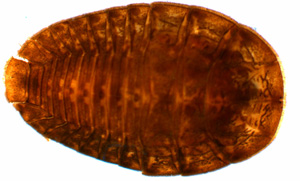 Aquatic Insects of Michigan
Aquatic Insects of Michigan
by Ethan Bright, Museum of Zoology Insect Division and School of Natural Resources and Environment
University of Michigan
- Home
- Species Lists
- Coleoptera
- Diptera
- Ephemeroptera
- Acanthametropodidae
- Ameletidae
- Ametropodidae
- Arthropleidae
- Baetidae
- Baetiscidae
- Behningiidae
- Caenidae
- Ephemerellidae
- Ephemeridae
- Heptageniidae
- Isonychiidae
- Leptohyphidae
- Leptophlebiidae
- Metretopodidae
- Neoephemeridae
- Oligoneuriidae
- Palingeniidae
- Polymitarcyidae
- Potamanthidae
- Pseudironidae
- Siphlonuridae
- Heteroptera
- Hymenoptera
- Lepidoptera
- Megaloptera
- Neuroptera (Sisyridae)
- Odonata
- Orthoptera
- Plecoptera
- Trichoptera
- Other Orders
- Keys/Identification
- Aquatic Insects of Michigan
Psephenidae (Water Pennies)
Water pennies are fairly common in streams and rivers as well as wave-swept portions of lakes in Michigan, which are represented by three species in two genera. The aquatic larvae are most commonly found by most collectors, their flattened, semi-circular shape giving their common name "water pennies." As larvae, both Psephenus herricki and the two species of Ectopria found in Michigan are grazers of periphyton (algae and diatoms) on substrate surfaces. Only the larvae are aquatic, a 6-instar semivoltine developmental period during which they feed on periphyton growing on substrates. Puparia are constructed in soft soils nearby water bodies from which the short-lived adults emerge, feeding little or not at all. Eggs are laid either in the water or on emergent vegetation. During the day, adults of Ectopria are found on nearby vegetation, and are attracted to light. Adults of Psephenus herricki are found on exposed rocks in stream riffles.
Larvae
(adapted from White and Roughley 2008, Hilsenhoff and Schmude 1992)
1a a. Ab9 with a ventral operculum closing a caudal chamber containing 3 tufts of retractile filamentous gills Ectopria LeConte, 2 b. Without gills on other parts of the abdomen c. Expanded lateral portions of abdominal segments separated d. Mesothorax with spiracles a. Ab9 without a ventral operculum, no anal gills Psephenus herricki (De Kay) b. Abdomen with 4 pairs of ventral tufts on c. Expanded lateral portions of abdominal segments fitting tightly together at margin d. Mesothorax without spiracles Larva of Psephenus herricki (Copyright © 2006 Ethan Bright) 2a(1a) a. Numerous dark asperities on all lateral abdominal projections and between dorsal longitudinal rows of asperities Ectopria leechi Brigham b. Setae on posterior margin of thoracic and abdominal terga clear and inconspicuous 2b a. Dark asperities mostly absent from lateral abdominal projections and from between dorsal longitudinal rows of asperities Ectopria nervosa (Melsheimer) b. Conspicuous, dark, brush-like setae arising from the posterior margins of thoracic and Ab1-7 terga
Pupae
(adapted from Lee et al. 2007)
1a a. Larval terga covering pupae Psepheninae, Psephenus herricki (De Kay) also: Paired spiracles on Ab1-7 1b a. Pupae exposed Eubriinae, Ectopria LeConte also: Paratergites slender and apically tapering
Adults
(adapted from White and Roughley 2008, Hilsenhoff 1992, Brigham 1981)
1a a. Posterior margin of pronotum crenulate or finely beaded Ectopria LeConte, 2 b. Males with at least the anterior claw on each tarsus forked at apex c. Males and females with five abdominal sternites 1b a. Posterior margin of pronotum smooth Psephenus herricki (De Kay) b. Males with base of claws without forked apex c. Males with seven visible abdominal sternites, females with six visible abdominal sternites 2a(1a) a. Elytron light brown with distinct dark brown vermiculations and four dark brown anastomosing lines extending toward the apex Ectopria leechi Brigham b. Legs and antennae testaceous or light brown c. Aedeagus of male broad, 0.4x as wide as long, without subapical callosities 2b a. Elytron uniformly brownish-black or black Ectopria nervosa (Melsheimer) b. Legs and antennae brown or black, although tarsi may be lighter c. Aedeagus of male elongate, <0.3x as wide as long with distinct subapical callosities on parameres
Psephenus herricki (De Kay)
This species is commonly found in riparian and wave-swept portions of lakes throughout Michigan. Brown and Murvosh (1974) and Murvosh (1971) give accounts on the biology and ecology of this species. Briefly, one commonly finds two size cohorts in Michigan, suggesting a two-year life cycle. During the summer, larvae emerge from the water to create a puparium just above the water surface. Eclosion occurs about 1-2 weeks later, with the adults typically found near the water or on top of objects projecting from the water surface. Whereas males remain above the surface, after mating the female soon enters the water to lay eggs, attaching several hundred eggs in flattened masses underneath stones and other substrates.
Neotype Male
General — Length 5.0 mm, greatest width 2.5 mm. Moderately depressed, elongate oval, narrowed in front, obtusely rounded behind. Rather densely pubescent, but even the longer suberect hairs are inconspicuous, those of the pronotal and elytral disks being less than about 0.125 mm in length. Cuticle of dorsum and appendages shining, finely and rather densely punctate; venter dull. Head rufo-piceous, paler just behind eyes. Pronotum rufo-piceous. Elytra dark reddish brown with slightly paler marginal flange. Venter dark ashen brown, the posterior margins of abdominal segments lighter in color. Appendages dark reddish brown above, somewhat lighter below, the tarsi lightest and rufo-testaceous.  Head. Broadly and very shallowly concave anteriorly between the eyes. Anterior margin truncate, not perceptibly raised or flanged. Vertex with a shallow concavity on each side just behind and mesial to eye. Width of head across eyes 1.0 mm. Eyes moderate in size, hemispheric. Antennae subserrate; short, not reaching elytral humeri. First antennal segment largest and longest, subequal in length to length of eye; segments 2, 3 and 11 next longest and subequal in length, though 2 is broader; segments 4 to 10 progressively but almost imperceptibly shorter. Clypeus very short and broad, arcuately emarginate at apex, directed downward at approximately a 90 degree angle from frons.
Head. Broadly and very shallowly concave anteriorly between the eyes. Anterior margin truncate, not perceptibly raised or flanged. Vertex with a shallow concavity on each side just behind and mesial to eye. Width of head across eyes 1.0 mm. Eyes moderate in size, hemispheric. Antennae subserrate; short, not reaching elytral humeri. First antennal segment largest and longest, subequal in length to length of eye; segments 2, 3 and 11 next longest and subequal in length, though 2 is broader; segments 4 to 10 progressively but almost imperceptibly shorter. Clypeus very short and broad, arcuately emarginate at apex, directed downward at approximately a 90 degree angle from frons.  Labrum arcuate at base, arcuately emarginate at apex, the front and back margins being essentially parallel.
Labrum arcuate at base, arcuately emarginate at apex, the front and back margins being essentially parallel. 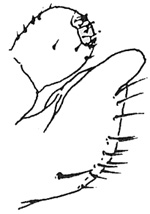 Maxillary palps slightly over half as long as antennae (0.9:1.6 mm), with basal segment smallest and subglobular, segment 2 about 3 times longer than segment 1, somewhat flattened, and expanded apically, segment 3 slightly shorter than 2, and segment 4 subequal 2 in length but broader and flatter (ca. as wide in dorsal as in lateral aspect). Subapical hairs on mesial surface of segment 2 almost as long as segment 3. Segment 4 oval in lateral aspect
Maxillary palps slightly over half as long as antennae (0.9:1.6 mm), with basal segment smallest and subglobular, segment 2 about 3 times longer than segment 1, somewhat flattened, and expanded apically, segment 3 slightly shorter than 2, and segment 4 subequal 2 in length but broader and flatter (ca. as wide in dorsal as in lateral aspect). Subapical hairs on mesial surface of segment 2 almost as long as segment 3. Segment 4 oval in lateral aspect 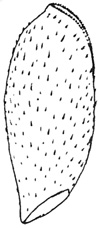 (Fig. 40).
(Fig. 40). 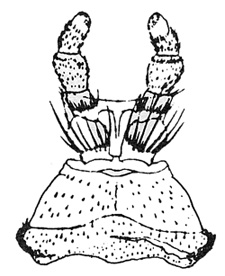 Labial palps sub- equal in length to second segment of antenna, the middle segment being largest and conspicuously hairy on its lateral surface; segment 3 subconical and subglabrous, with a white sensory apex. Pronotum. Length 1.25 mm, greatest width 2.05 mm just anterior to base. Sides converging so that anterior margin is about half as wide as base. Broadly and evenly convex except for feebly explanate lateral margins and somewhat depressed posterior margin and a very feeble, glabrous, longitudinal ridge extending from about basal fifth to near middle. Basal margin broadly bisinuate. Basal angles subacute, directed slightly inward. Apical angles rounded. Anterior margin almost straight. Width
base 2.0 mm, width at apex 1.05 mm. Scutellum.—About 0.25 mm long and wide; anterior margin straight, sides rounded, posterior margin subacute. Surface densely and minutely punctate, sparsely pubescent if at all; dull gray in color.
Labial palps sub- equal in length to second segment of antenna, the middle segment being largest and conspicuously hairy on its lateral surface; segment 3 subconical and subglabrous, with a white sensory apex. Pronotum. Length 1.25 mm, greatest width 2.05 mm just anterior to base. Sides converging so that anterior margin is about half as wide as base. Broadly and evenly convex except for feebly explanate lateral margins and somewhat depressed posterior margin and a very feeble, glabrous, longitudinal ridge extending from about basal fifth to near middle. Basal margin broadly bisinuate. Basal angles subacute, directed slightly inward. Apical angles rounded. Anterior margin almost straight. Width
base 2.0 mm, width at apex 1.05 mm. Scutellum.—About 0.25 mm long and wide; anterior margin straight, sides rounded, posterior margin subacute. Surface densely and minutely punctate, sparsely pubescent if at all; dull gray in color. 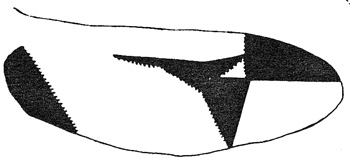
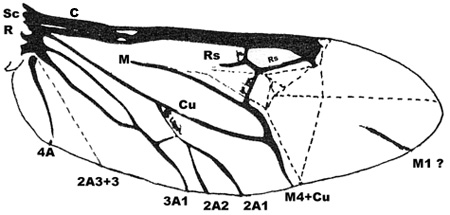 Elytra. — Length 3.75 mm, broadest (2.5 mm) near middle. Apices rounded and slightly divergent. Margins feebly explanate. Prosternum. —Length 0.75 mm, width 1.35 mm. Medially carinate from base to apex. Process about 0.625 mm long, 0.055 mm wide at narrowest point between coxae. Mesosternum. — About 0.075 mm wide between coxae. Legs. — Front and middle tarsi with first four segments apically emarginate and each segment extending ventrally beneath next segment apically; in dorsal aspect with first segment shortest, second through fourth subequal, and the combined length of the first four segments subequal to that of the fifth; first two segments bearing relatively prominent ventral brushes of rather long, pale, stiff hairs; first segment almost as wide as apex of fifth, second to fourth narrower. Hind tarsi more slender and lacking ventral brushes on first two segments. Wing venation. — (Fig. 35) The specimen figured by West (1929) from the vicinity of Ithaca. New York, although not from the type locality, is not far removed from the type locality. His figure is reproduced in Fig. 35, and is typical of the species. Abdomen. With rather long, pale, apically-directed hairs on midventral portions of visible segments 4 and 5 and covering exposed portions of segments 6 and 7. Genitalia (of neo-paratype). — (Figs. 24-26) Ventral sclerite of penis with basal margin feebly emarginate; shaft about 4 times as long as maximal width at expanded base. Penis subequal in length to parameres and extending slightly beyond their apices. Parameres in dorsal or ventral aspect abruptly shouldered near apex; in lateral aspect with basal ventral angle broadly rounded. Basal piece hemicylindric in shape and subequal in length to parameres. Basal margins of parameres protruded anteriorly near mid-dorsal line. Variations among males. Since the geographic range of this species is extensive, it is not surprising that considerable variation exists. In size, specimens at hand range from 3.85 to 5.7 mm long, from 2.0 to 3.0 mm wide, 0.85-1.2 mm across the eyes, pronotal length 1.05-1.5 mm, pronotal width 1.6-2.4 mm, elytral length 2.9-4.25 mm. In color, the head and pronotum are often black, the elytra range from medium brown to black, at times with alternating longitudinal bands of lighter and darker, the legs range from testaceous to dark brown, the greatest variation perhaps being in the femora. In many specimens the dorsal pubescence imparts a bronzed sheen. The median pronotal ridge is often totally absent. On each side of this pronotal region one or two depressions may be evident. The lateral margins of the elytra are noticeably more explanate in some specimens than in others. The antennal segments vary in shape, especially in the degree to which they appear subserrate. The conformation of penis and parameres vary somewhat, the ventral sclerite of the penis often being somewhat broader and slightly constricted in part of the shaft and the basal angles of this sclerite subacute rather than rounded.
Elytra. — Length 3.75 mm, broadest (2.5 mm) near middle. Apices rounded and slightly divergent. Margins feebly explanate. Prosternum. —Length 0.75 mm, width 1.35 mm. Medially carinate from base to apex. Process about 0.625 mm long, 0.055 mm wide at narrowest point between coxae. Mesosternum. — About 0.075 mm wide between coxae. Legs. — Front and middle tarsi with first four segments apically emarginate and each segment extending ventrally beneath next segment apically; in dorsal aspect with first segment shortest, second through fourth subequal, and the combined length of the first four segments subequal to that of the fifth; first two segments bearing relatively prominent ventral brushes of rather long, pale, stiff hairs; first segment almost as wide as apex of fifth, second to fourth narrower. Hind tarsi more slender and lacking ventral brushes on first two segments. Wing venation. — (Fig. 35) The specimen figured by West (1929) from the vicinity of Ithaca. New York, although not from the type locality, is not far removed from the type locality. His figure is reproduced in Fig. 35, and is typical of the species. Abdomen. With rather long, pale, apically-directed hairs on midventral portions of visible segments 4 and 5 and covering exposed portions of segments 6 and 7. Genitalia (of neo-paratype). — (Figs. 24-26) Ventral sclerite of penis with basal margin feebly emarginate; shaft about 4 times as long as maximal width at expanded base. Penis subequal in length to parameres and extending slightly beyond their apices. Parameres in dorsal or ventral aspect abruptly shouldered near apex; in lateral aspect with basal ventral angle broadly rounded. Basal piece hemicylindric in shape and subequal in length to parameres. Basal margins of parameres protruded anteriorly near mid-dorsal line. Variations among males. Since the geographic range of this species is extensive, it is not surprising that considerable variation exists. In size, specimens at hand range from 3.85 to 5.7 mm long, from 2.0 to 3.0 mm wide, 0.85-1.2 mm across the eyes, pronotal length 1.05-1.5 mm, pronotal width 1.6-2.4 mm, elytral length 2.9-4.25 mm. In color, the head and pronotum are often black, the elytra range from medium brown to black, at times with alternating longitudinal bands of lighter and darker, the legs range from testaceous to dark brown, the greatest variation perhaps being in the femora. In many specimens the dorsal pubescence imparts a bronzed sheen. The median pronotal ridge is often totally absent. On each side of this pronotal region one or two depressions may be evident. The lateral margins of the elytra are noticeably more explanate in some specimens than in others. The antennal segments vary in shape, especially in the degree to which they appear subserrate. The conformation of penis and parameres vary somewhat, the ventral sclerite of the penis often being somewhat broader and slightly constricted in part of the shaft and the basal angles of this sclerite subacute rather than rounded.
Females. Length 4.6-6.3 mm, width 2.5-3.45 mm, width across eyes 0.9-1.15 mm, pronotal length 1.1-1.4 mm, pronotal width 1.9.2.55 mm, elytral length 3.6-4.75 mm. Antennae somewhat smaller than in male and more nearly moniliform than subserrate. Maxillary palps much less conspicuous than in male, being smaller, shorter (distinctly less than half as long as antennae), and with apical segment not appreciably expanded. Pronotum dull gray to black, with lateral margins much more explanate than in male. Elytra and abdomen larger than in male. Prosternal process and intercoxal mesosternal groove about twice as wide as in male. Abdominal sternites without median apical pale hairs. All tarsi similar, without prominent ventral brushes on first two segments. Wing venation essentially as in male, but some specimens apparently lacking vein 2A2.
References
-
Brigham WU. 1981. Ectopria leechi, a new false water penny from the United States (Coleoptera: Eubriidae). Pan-Pacific Entomologist 57(1):313-320.
Brown HP, Murvosh CM. 1974. A revision of the genus Psephenus (Waterpenny Beetles) of the United States and Canada (Coleoptera, Dryopoidea, Psephenidae). Transactions of the American Entomological Society 100(3):289-340.
Hilsenhoff WL, Schmude KL. 1992. Riffle beetles of Wisconsin (Coleoptera: Dryopidae, Elmidae, Lutrochidae, Psephenidae) with notes on distribution, habitat, and identification. The Great Lakes Entomologist 25(3):191-213.
Murvosh CM. 1971. Ecology of the water penny beetle Psephenus herricki (De Kay). Ecological Monographs 41(1):79-96.
White DS, Roughley RE. 2008. Aquatic Coleoptera, pp. 571-671 in Merritt RW, Cummins KW, Berg MB (eds.), An Introduction to the Aquatic Insects of North America, Fourth Edition. Kendall/Hunt Publishing Company, Dubuque, Iowa, USA.
